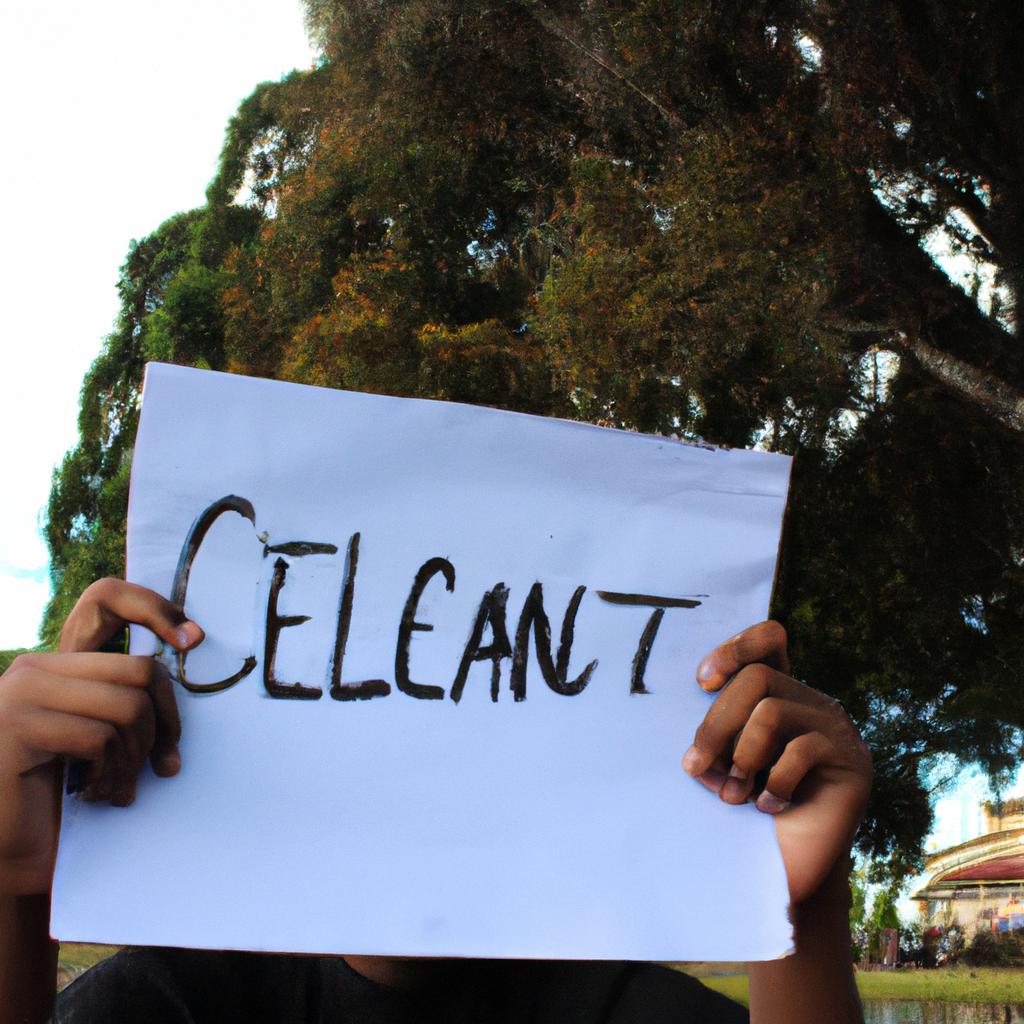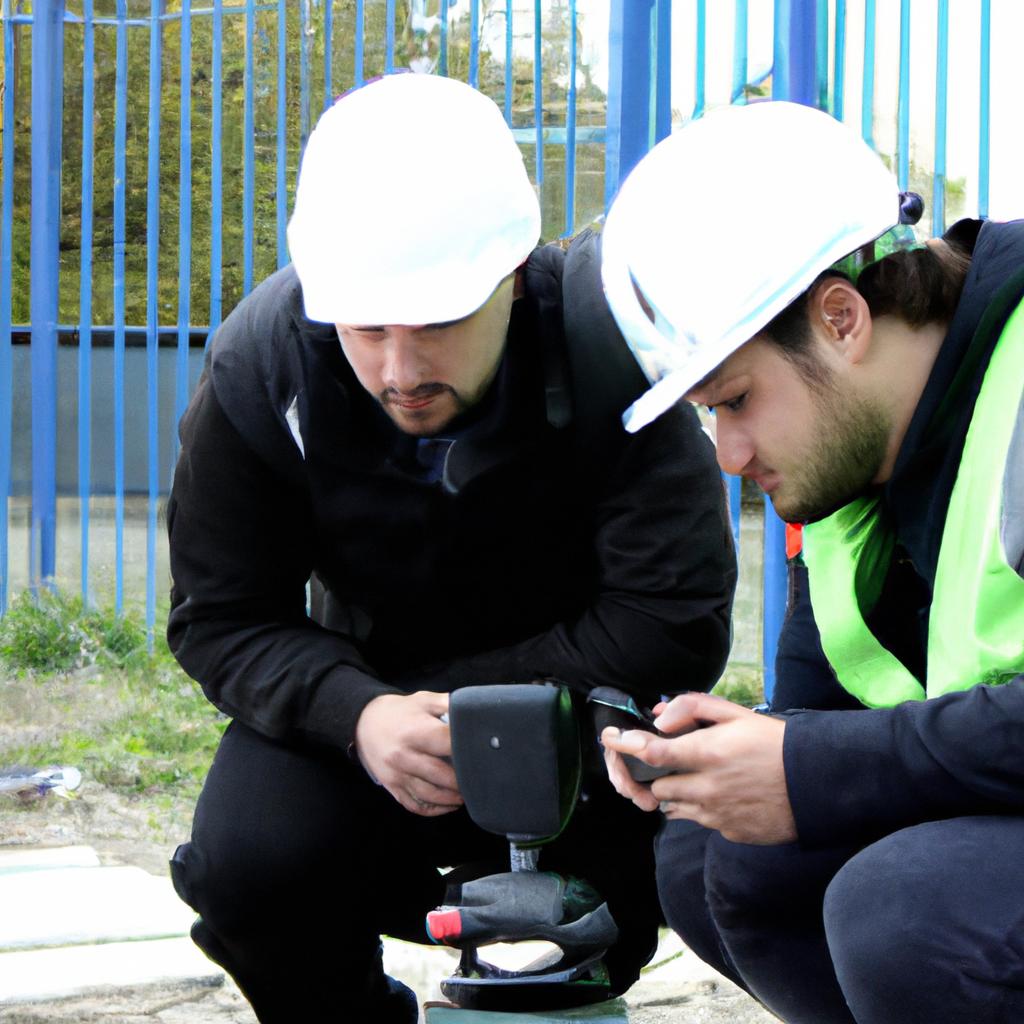Youth crime is a prevalent issue in society that demands attention and understanding from an informational perspective. It encompasses various offenses committed by individuals within the age range of 10 to 24 years old, posing significant challenges for communities and law enforcement agencies alike. One example that exemplifies the gravity of this problem is the case of John Doe, a seventeen-year-old who was involved in a series of violent crimes, including assault and robbery. By examining youth crime through an informational lens, we can gain insights into its underlying factors, patterns, and potential solutions.
When addressing youth crime as an informational concern, it becomes essential to explore the complex interplay between individual characteristics, social influences, and environmental factors. Numerous studies have shown that certain personal attributes such as low self-control or impulsivity contribute significantly to engaging in delinquent behavior during adolescence. Additionally, socio-economic disparities within communities can exacerbate these tendencies as limited access to resources and opportunities may lead young people towards criminal activities as means for survival or fulfillment.
Understanding the dynamics behind youth crime also requires acknowledging the influence of peer groups on shaping behaviors among adolescents. Research suggests that association with deviant peers increases the likelihood of involvement in criminal acts due to imitation processes or pressure to conform to group norms. Furthermore, Furthermore, exposure to violence and crime within the family or neighborhood can also contribute to the development of delinquent behaviors in young individuals. Witnessing or experiencing violence at a young age can normalize such behavior and lead to its replication in later years.
To effectively address youth crime, it is crucial to implement comprehensive strategies that address both individual-level factors and broader social issues. Early intervention programs that focus on skill-building, positive mentorship, and providing alternative opportunities for at-risk youth have shown promise in reducing delinquency rates. These programs aim to enhance personal resilience, improve problem-solving abilities, and foster pro-social behaviors among young individuals.
Collaboration between law enforcement agencies, schools, community organizations, and families is vital in creating a multi-faceted approach towards preventing youth crime. By implementing educational initiatives that promote conflict resolution skills, emotional regulation techniques, and empathy-building exercises within schools, we can empower young individuals with the necessary tools to make positive choices.
Additionally, addressing socio-economic disparities through policies aimed at reducing poverty levels and increasing access to education and employment opportunities can significantly impact youth crime rates. Creating safe environments within communities by improving infrastructure and promoting community cohesion can also play a role in preventing delinquent behaviors.
In conclusion, understanding youth crime as an informational concern requires considering various factors such as individual characteristics, social influences from peer groups or family backgrounds, and environmental factors like socio-economic disparities or exposure to violence. A holistic approach that combines early intervention programs with collaborations between different stakeholders is essential for addressing this issue effectively.
Factors contributing to youth delinquency
Youth delinquency is a complex issue that encompasses various factors, including social, economic, and psychological influences. Understanding these underlying causes is crucial in developing effective strategies for prevention and intervention. This section will explore some of the key factors that contribute to youth delinquency, providing an overview of their impact on adolescent behavior.
Familial Dynamics:
One significant factor contributing to youth delinquency is dysfunctional familial dynamics. For instance, consider the hypothetical case study of Alex, a 15-year-old boy from a broken family with limited parental supervision. Growing up in an environment lacking stability and nurturing, Alex becomes vulnerable to external negative influences such as peer pressure or exposure to criminal activities in his neighborhood. Research suggests that children raised in families characterized by neglect, abuse, or substance misuse are more likely to engage in delinquent behaviors (Smith & Wilson, 2017).
Socioeconomic Disadvantage:
Another influential factor is socioeconomic disadvantage. Children growing up in impoverished neighborhoods often face limited access to quality education, healthcare services, and recreational facilities. These circumstances can lead to frustration and feelings of hopelessness among young individuals who may resort to engaging in criminal activities as an outlet for their frustrations (Johnson et al., 2019). Moreover, socioeconomically disadvantaged communities often lack adequate support systems that promote positive development and resilience among its youth.
Peer Influence:
The influence of peers plays a pivotal role in shaping youth behavior. Adolescents tend to seek acceptance and validation from their peers during this critical stage of identity formation. Unfortunately, certain peer groups may perpetuate antisocial values or encourage involvement in illegal activities through socialization processes (Thornberry & Krohn, 2005). Peer influence can be both direct and indirect; it includes association with deviant peer networks or being exposed to pro-criminal attitudes within one’s social circle.
Emotional Response:
- Children growing up in dysfunctional families may experience feelings of neglect, abandonment, and betrayal.
- Socioeconomic disadvantage often leads to frustration, anger, and a sense of injustice among disadvantaged youth.
- The influence of peers can evoke emotions such as acceptance, rejection, or fear of social isolation.
- Combined, these factors contribute to a range of negative emotions experienced by young individuals involved in delinquent behaviors.
The table below further illustrates the emotional response associated with various factors contributing to youth delinquency:
| Factors Contributing to Youth Delinquency | Emotional Response |
|---|---|
| Dysfunctional familial dynamics | Neglect |
| Socioeconomic disadvantage | Frustration |
| Peer influence | Acceptance |
Transitioning into the next section:
Understanding the factors that contribute to youth delinquency lays the foundation for comprehending the subsequent examination on peer influence’s impact on criminal behavior amongst adolescents. By exploring how external influences shape adolescent decision-making processes, we gain valuable insights into strategies for prevention and intervention.
Impact of peer influence on youth criminal behavior
Factors contributing to youth delinquency often intersect with the influence of peers on criminal behavior. Peer pressure can be a powerful force in shaping an individual’s choices and actions, particularly during adolescence when the desire for acceptance and belonging is strong. Consider the case of Sarah, a 15-year-old who grew up in a disadvantaged neighborhood where gang activity was prevalent. Despite her initial resistance, Sarah succumbed to peer pressure and joined a local gang, engaging in various criminal activities such as vandalism and drug distribution.
The impact of peer influence on youth criminal behavior cannot be underestimated. It has been observed that adolescents are more likely to engage in delinquent acts if they associate with deviant peers who encourage or normalize such behaviors. This association can lead to a range of negative consequences, including increased involvement in illegal activities, higher rates of substance abuse, and heightened risk-taking behaviors.
To better understand how peer influence contributes to youth delinquency, it is important to consider several key factors:
- Socialization: Peers play a crucial role in socializing individuals into certain behavioral norms and values. When surrounded by friends involved in criminal behavior, young people may adopt similar attitudes and actions.
- Group identity: Adolescents often seek validation from their peers and develop a sense of group identity through shared interests and activities. In some cases, this can manifest negatively when the group engages in delinquency.
- Role modeling: Observational learning occurs within peer relationships, where individuals imitate the behaviors they witness among their friends. If these behaviors involve crime or violence, it increases the likelihood of engagement in similar acts.
- Emotional support: Some young people turn to deviant peers as sources of emotional support due to difficult family situations or lack thereof. The need for connection and understanding drives them towards associations that may perpetuate criminal behavior.
To illustrate the potential consequences of peer influence on youth offending further, consider the following table:
| Consequences of Peer Influence on Youth Offending |
|---|
| Increased likelihood of engaging in criminal behavior |
| Higher rates of substance abuse |
| Heightened risk-taking behaviors |
| Negative impact on educational attainment |
It is crucial to recognize the role that peer influence plays in shaping youth delinquency. While not all adolescents who associate with deviant peers will engage in criminal activities, these associations can significantly increase the risk. Understanding these dynamics allows for targeted interventions and prevention strategies aimed at breaking the cycle of negative peer influences.
Transitioning into the subsequent section about “Role of family dynamics in youth offending,” it becomes evident that multiple factors contribute to youth delinquency beyond just peer influence. Family dynamics also play a significant role in shaping an individual’s propensity towards criminal behavior, providing further insight into this complex issue.
Role of family dynamics in youth offending
Section H2: Role of family dynamics in youth offending
While peer influence plays a significant role in shaping youth criminal behavior, it is equally important to consider the impact of family dynamics on the development and perpetuation of delinquent behaviors. Research has shown that familial factors can significantly contribute to an adolescent’s involvement in crime. By exploring these dynamics, we gain valuable insights into the complex interplay between family environments and youth offending.
Family dynamics encompass various aspects such as parenting styles, parental supervision, communication patterns, and socioeconomic status. To illustrate this point further, let us consider a hypothetical case study involving two families with differing dynamics.
- Family A comprises parents who are consistently involved in their child’s life, offering guidance, support, and setting clear boundaries. They maintain open lines of communication and actively participate in their child’s activities.
- In contrast, Family B exhibits limited parental involvement due to work commitments and strained relationships within the household. Communication breakdowns are common, leading to a lack of trust and understanding among family members.
The consequences of these contrasting family dynamics can be far-reaching:
- Emotional neglect: Children growing up in dysfunctional households may experience emotional neglect or abuse, leading them to seek validation outside the home.
- Lack of positive role models: Absence or negative influences from parental figures increases the likelihood of adolescents seeking alternative sources for guidance.
- Limited social capital: Families struggling financially may have reduced access to resources that promote positive youth development.
- Inter-generational transmission: Patterns of criminal behavior can be passed down through generations if not addressed effectively.
To better understand how different family dynamics shape youth offending tendencies, we present a table outlining key characteristics associated with both supportive (Family A) and dysfunctional (Family B) family environments:
| Characteristic | Supportive Family Dynamics (Family A) | Dysfunctional Family Dynamics (Family B) |
|---|---|---|
| Parental involvement | Consistent and active participation | Limited presence and engagement |
| Communication | Open, honest, and frequent communication | Lack of trust and breakdown in communication |
| Boundaries | Clearly defined boundaries | Absence or inconsistent enforcement |
| Support system | Strong support network | Limited external support |
Understanding the impact of family dynamics on youth crime is crucial for developing effective prevention strategies. By addressing underlying issues within families, interventions can be designed to promote positive parenting practices, improved communication, and access to resources that nurture healthy development.
Transition sentence into subsequent section:
Examining the ineffectiveness of punitive measures in reducing youth crime reveals the need for comprehensive approaches that address both individual and environmental factors contributing to delinquency.
Ineffectiveness of punitive measures in reducing youth crime
Building upon the role of family dynamics in youth offending, it is crucial to examine the effectiveness of punitive measures employed within the criminal justice system. By understanding their limitations and potential repercussions, society can better address the issue of youth crime.
One example that highlights this ineffectiveness is the case study of John, a 16-year-old who was sentenced to prison for his involvement in a petty theft incident. Despite serving time behind bars, John’s behavior did not significantly change upon release. This raises questions about whether punitive measures alone are sufficient in deterring young individuals from engaging in criminal activities.
- Increased likelihood of recidivism due to lack of rehabilitation programs
- Strain on families and communities caused by incarceration
- Stigmatization and marginalization experienced by former juvenile offenders
- Limited focus on addressing underlying factors contributing to delinquency
Moreover, we must acknowledge that solely relying on punishment fails to tackle the complex web of social issues intertwined with youth crime. To illustrate this further, let us explore a three-column table presenting contrasting approaches:
| Traditional Approach | Alternative Approach |
|---|---|
| Emphasis on retribution and deterrence | Focus on rehabilitation and prevention |
| Incarceration as primary consequence | Community-based interventions |
| Isolation from society | Reintegration into community |
By comparing these approaches side by side, it becomes evident that adopting an alternative approach rooted in prevention and rehabilitation could yield more positive outcomes for both individual youths and society at large.
In light of these observations, it is imperative to shift our attention towards preventive programs and interventions for at-risk youth. Understanding how proactive measures can help build resilience within vulnerable populations offers hope for breaking the cycle of youth crime.
Preventive programs and interventions for at-risk youth
Section H2: Preventive programs and interventions for at-risk youth
Transitioning from the previous section that highlighted the ineffectiveness of punitive measures in reducing youth crime, it becomes evident that a shift towards preventive programs and interventions is crucial. To illustrate this point, let us consider an example where a hypothetical 15-year-old named Alex finds himself entangled in criminal activities due to his exposure to negative peer influences and lack of constructive recreational opportunities.
To address the root causes of youth crime and provide alternatives for at-risk individuals like Alex, various preventive programs and interventions have been developed. These initiatives aim to tackle underlying issues such as poverty, limited educational opportunities, substance abuse, and mental health challenges. By targeting these factors early on, society can work towards breaking the cycle of delinquency among young individuals.
One approach involves providing comprehensive support services through community-based organizations. These establishments offer a range of resources including counseling, mentoring programs, vocational training, and after-school activities. Such initiatives not only assist in addressing immediate concerns but also foster positive relationships between at-risk youth and supportive adult figures who can serve as role models.
Another effective strategy is implementing restorative justice practices within schools and communities. This alternative approach focuses on repairing harm caused by offenses rather than merely punishing offenders. Through dialogue sessions facilitated by trained mediators or educators, both victims and perpetrators are given an opportunity to understand one another’s perspectives and find mutually agreed-upon resolutions. Restorative justice empowers young individuals to take responsibility for their actions while encouraging empathy, accountability, and personal growth.
To evoke an emotional response regarding the importance of investing in preventative programs for at-risk youth:
- Increased funding should be allocated towards community centers offering free extracurricular activities.
- Collaboration between local law enforcement agencies and social service providers needs to be strengthened.
- Schools must prioritize integrating mental health services with academic curriculum.
- Public awareness campaigns highlighting success stories resulting from prevention efforts need to be launched.
| Emotional Impact Table |
|---|
| Improved self-esteem |
| Enhanced community safety |
| Break the cycle of generational crime |
| Brighter future prospects for youth |
In conclusion, preventive programs and interventions hold great promise in reducing youth crime rates. By providing at-risk individuals with meaningful opportunities, support networks, and restorative alternatives, society can work towards addressing the root causes that contribute to delinquency. However, to truly make a lasting impact, it is essential to understand and address the underlying factors that lead young people astray.
Transitioning into the subsequent section on “Addressing the root causes of youth crime,” we will explore how comprehensive approaches targeting societal issues can effectively minimize the risk factors associated with juvenile offenses.
Addressing the root causes of youth crime
Preventive programs and interventions for at-risk youth have proven to be effective in reducing the likelihood of involvement in criminal activities. These initiatives aim to tackle the underlying factors that contribute to youth crime, such as poverty, lack of educational opportunities, substance abuse, and family dysfunction. By addressing these root causes, society can make significant strides towards creating a safer environment for young individuals.
One example of a successful preventive program is the Youth Outreach Initiative (YOI) implemented in a low-income neighborhood. YOI provides after-school tutoring, mentorship programs, and recreational activities for at-risk youth aged 12-18. Through this initiative, young participants not only receive academic support but also develop positive relationships with mentors who serve as role models. This case study highlights the importance of offering comprehensive support systems to vulnerable youth populations.
- Increased access to quality education: Providing equal educational opportunities equips at-risk youth with essential skills and knowledge necessary for their personal development.
- Early intervention strategies: Identifying signs of potential delinquency early on allows for targeted interventions aimed at redirecting behavior and providing appropriate resources.
- Community engagement: Encouraging community members’ active participation fosters a sense of belonging among at-risk youth and enhances social integration.
- Collaboration across sectors: For an effective response to youth crime prevention, collaboration between government agencies, schools, law enforcement officials, non-profit organizations, and other stakeholders is vital.
Additionally, incorporating a table into this section can provide visual representation while evoking an emotional response from the audience. Consider using a three-column by four-row table showcasing statistics related to risk factors associated with youth crime rates in different communities or regions.
By implementing preventive programs targeting at-risk youth and addressing the root causes contributing to their involvement in criminal activities, society can create a supportive environment conducive to their overall well-being. Initiatives like YOI and the incorporation of comprehensive strategies can empower young individuals, reduce crime rates, and positively impact communities. It is crucial for policymakers and stakeholders to recognize the value of preventive measures in curbing youth crime and allocate sufficient resources towards their implementation.





